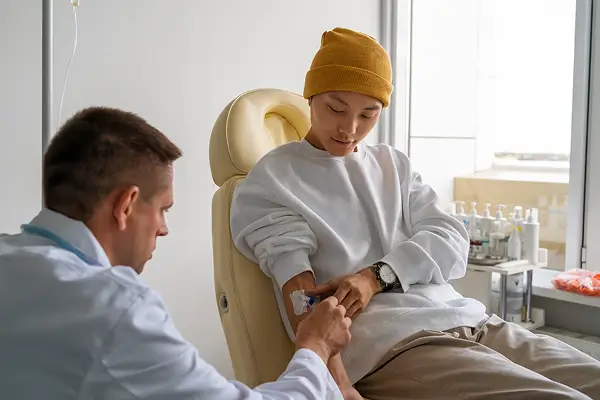Chemotherapy-induced peripheral neuropathy (CIPN) is a common and often debilitating side effect of certain chemotherapy drugs, particularly those used in the treatment of cancer. It occurs when chemotherapy damages the peripheral nervous system, which includes nerves outside of the brain and spinal cord. CIPN can significantly impact a patient’s quality of life, leading to symptoms such as pain, tingling, numbness, and weakness in the hands and feet. The severity of chemotherapy induced peripheral neuropathy CIPN varies from patient to patient, and in some cases, it can persist long after the chemotherapy has ended. Understanding the causes, symptoms, diagnosis, treatment, and prognosis of CIPN is essential for managing this condition effectively.
Causes of Disease
The primary causes of Chemotherapy-Induced Peripheral Neuropathy (CIPN) are the neurotoxic effects of certain chemotherapy agents, which include platinum-based drugs (like cisplatin and carboplatin), taxanes (such as paclitaxel and docetaxel), and vinca alkaloids (such as vincristine). These drugs can damage the peripheral nerves, particularly the sensory and motor nerves in the extremities. The exact mechanisms by which chemotherapy causes nerve damage are not fully understood but are believed to involve direct toxicity to nerve fibers, inflammation, and disruptions in nerve cell signaling. Risk factors for developing CIPN include the type of chemotherapy drug used, the dose, the duration of treatment, and pre-existing conditions such as diabetes or vitamin deficiencies, which can increase vulnerability to nerve damage.
Symptoms of Disease
Symptoms of CIPN manifest as a range of sensory and motor disturbances, with the most common symptoms being tingling, burning sensations, numbness, and pain in the hands and feet. Patients may also experience muscle weakness, difficulty walking, and problems with balance and coordination, which can severely impair daily activities. In more severe cases, the condition can affect the ability to perform fine motor tasks such as buttoning a shirt or typing. Symptoms of chemotherapy induced peripheral neuropathy often start in a “stocking-glove” pattern, affecting the distal parts of the extremities, and can progressively worsen during and after chemotherapy. The severity and duration of chemotherapy induced peripheral neuropathy symptoms vary, with some patients experiencing only mild discomfort while others may face long-term or permanent nerve damage.
Diagnosis of Disease
Diagnosing CIPN involves a thorough clinical assessment that includes a detailed patient history, physical examination, and, when necessary, electrophysiological tests to evaluate nerve function. The patient’s history is crucial for identifying the use of neurotoxic chemotherapy agents and understanding the timing and progression of symptoms. Electromyography (EMG) and nerve conduction studies (NCS) can help assess the extent of nerve damage by measuring the electrical activity of muscles and the speed of nerve signals. In some cases, additional imaging studies, such as MRI, may be used to rule out other potential causes of neuropathy. However, the diagnosis of CIPN is primarily clinical, based on the patient’s reported symptoms and the exclusion of other possible causes.
Treatment of Disease
Treatment for chemotherapy induced peripheral neuropathy focuses on managing symptoms and improving quality of life, as there is currently no definitive cure for the condition. Symptomatic treatment may include the use of pain relievers, such as nonsteroidal anti-inflammatory drugs (NSAIDs) or opioids for severe pain. Antidepressants like amitriptyline and anticonvulsants such as gabapentin or pregabalin are commonly prescribed to alleviate nerve-related pain and discomfort. Physical therapy can also be helpful in improving strength, balance, and coordination, while occupational therapy may assist with adapting to daily tasks. In some cases, dose modification or discontinuation of the chemotherapy drug may be considered if the symptoms are severe. Emerging CIPN treatments, such as the use of cryotherapy or nerve-protective agents, are being studied, but no widely approved treatments for preventing or reversing CIPN are available as of now.

Prognosis
The prognosis varies depending on the severity of symptoms and the individual patient. For many patients, symptoms of chemotherapy induced peripheral neuropathy (CIPN) improve or stabilize after the completion of chemotherapy, though recovery can be slow and may take months or even years. In some cases, however, the nerve damage can be permanent, leading to chronic pain or long-term disability. Early recognition and management of CIPN may help prevent worsening of the condition, and patients who experience mild symptoms often recover fully over time. However, in more severe cases, permanent disability may occur, particularly if the chemotherapy regimen included highly neurotoxic drugs or if the patient had predisposing factors. Ongoing research into neuroprotective strategies and treatments may improve the outlook for future patients.
If you or a loved one is experiencing symptoms of Chemotherapy-Induced Peripheral Neuropathy (CIPN), don’t wait to seek help. Early recognition and management can make a significant difference in your quality of life. Contact our pain management specialist today to discuss and create a personalized plan to manage CIPN effectively.



